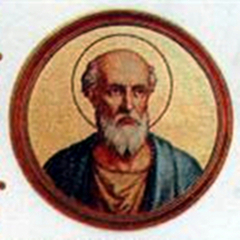Text and Illustrations from Wikipedia - the free encyclopaedia,
unless otherwise stated.

English: Einsiedeln Abbey Church,
Switzerland.
Deutsch: Klosterkirche in Einsiedeln,
Switzerland.
Photo: 29 November 2010.
Source: Own work.
Author: Roland zh.
(Wikimedia Commons)

English: Interior of Einsiedeln Abbey, Switzerland.
Français: Vue Intérieure.
Photo: 8 August 2011.
Source: Own work.
Author: Caro.ray.
(Wikimedia Commons)
Saint Meinrad was educated at The Abbey School, on Reichenau Island, in Lake Constance, Switzerland, under his kinsmen, Abbot Hatto and Abbot Erlebald, where he became a Monk and was Ordained a Priest. After some years at Reichenau, and at a dependent Priory, on Lake Zurich, he embraced an eremitical life and established his Hermitage on the slopes of Etzel Mountain. He died on 21 January 861 A.D., at the hands of two robbers, who thought that the Hermit had some precious treasures, but, during the next eighty years, the place was never without one or more Hermits emulating Meinrad's example. One of them, named Eberhard, previously Provost of Strasbourg, erected, in 934 A.D., a Monastery and Church there, of which he became the first Abbot.

English: Nave of The Abbatial Cathedral Saint Mauritius, Einsiedeln,
Canton of Schwyz, Central Switzerland.
Deutsch: Langhaus der Abteikathedrale Sankt Mauritius, Einsiedeln,
Kanton Schwyz, Zentral-Schweiz.
Photo: 29 January 2013.
Source: Own work.
Author: Zairon.
(Wikimedia Commons)

English: Einsiedeln Abbey, Switzerland.
Deutsch: Kloster Einsiedeln,
Einsiedeln, Switzerland.
Photo: 26 January 2013.
Source: Own work.
Author: Roland zh.
(Wikimedia Commons)
For the learning and piety of its Monks, Einsiedeln Abbey has been famous for a thousand years, and many Saints and scholars have lived within its walls. The study of Letters, Printing, and Music have greatly flourished there, and the Abbey has contributed largely to the glory of The Benedictine Order. It is true that discipline declined somewhat in the 15th-Century and The Rule became relaxed, but Ludovicus II, a Monk of Saint Gall, who was Abbot of Einsiedeln 1526-1544, succeeded in restoring the stricter observance.

English: Choir of The Abbatial Cathedral Saint Mauritius, Einsiedeln,
Canton of Schwyz, Central Switzerland.
Deutsch: Chor der Abteikathedrale St. Mauritius, Einsiedeln,
Kanton Schwyz, Zentral-Schweiz.
Photo: 29 January 2013.
Source: Own work.
Author: Zairon.
(Wikimedia Commons)

Einsiedeln Abbey,
Switzerland.
Photo: 27 July 2006.
Source: Own work.
Author: Markus Bernet.
(Wikimedia Commons)
14 September and 13 October are the chief Pilgrimage days, the former being the Anniversary of the miraculous Consecration of Eberhard's Basilica, and the latter that of The Translation of Saint Meinrad's Relics from Reichenau Island to Einsiedeln Abbey, in 1039. The millennium of Saint Meinrad was kept there with great splendour in 1861, as well as that of the Benedictine Monastery, in 1934.
The great Church has been many times rebuilt, the last time by Abbot Maurus between 1704 and 1719. The last big renovation ended after more than twenty years in 1997. The Library contains nearly 250,000 volumes and many priceless Manuscripts. The work of the Monks is divided chiefly between Prayer, work and study. At Pilgrimage times, the number of Confessions heard is very large.

Saint Meinrad Arch-Abbey,
Indiana,
United States of America.
Photo: 23 June 2008.
Source: Own work.
Author: Chris Light.
Attribution: Chris Light at en.wikipedia
(Wikimedia Commons)
The Benedictine Community, at Saint Meinrad Arch-Abbey, consists of men who dedicate their lives to Prayer and work. They gather in Community five times a day — for Morning Prayer, Mass, Noon Prayer, Evening Prayer and Compline — to Pray for The Church and the World. Guests often join the Monks in Prayer in the Arch-Abbey.
Gregorian Chant is sung in The Canonical Hours of The Monastic Office, primarily in Antiphons, used to sing The Psalms, in the Great Responsories of Matins, and the Short Responsories of The Lesser Hours and Compline. The Psalm Antiphons of The Office tend to be short and simple, especially compared to the complex Great Responsories. In addition, the Monks spend private time reading Spiritual and Religious material. They live under The Rule of Saint Benedict, which are the 6th-Century A.D., instructions for Community Living, written by Saint Benedict.

This is a representation of the Coat-of-Arms of
Saint Meinrad Arch-Abbey in Saint Meinrad,
Indiana, United States of America.
Blazon: Azure, a Ship with one Sail, Argent, the Mast terminating in a Cross, the Sail charged with the Greek letters Chi Rho, Sable, resting on a Sea Barry Wavy of six, Argent and Azure; on a Chief, Or, two Eagles (Ravens ?) rising to Dexter, Sable. [1].
Date: 6 August 2012.
Source: Own work.
Author: Alekjds.
(Wikimedia Commons)
In 1854, when the Monastery was again facing suppression, a colony was sent to The United States, from Einsiedeln, to minister to the local German-speaking population and to develop a place of refuge, if needed. Daughter Houses began to be Founded, the first being Saint Meinrad, Indiana, and, in 1881, these were formed into the Swiss-American Congregation, which, in 2013, comprised fourteen Monasteries from Canada, in the North, down to Guatemala, ten of which were directly Founded from Einsiedeln. In The Fall of 1887, Einsiedeln Abbey sent eight Novices, and one Professed Monk, to Subiaco, Arkansas. The Reverend Father Gall D'Aujourd'hui, O.S.B., is considered to be the Co-Founder of Subiaco Abbey and Academy.

English: The Nave,
Einsiedeln Abbey,
Switzerland.
Photo: 26 January 2013.
Source: Own work.
Author: Roland zh.
(Wikimedia Commons)
Located in separate Cantons, Einsiedeln Abbey and Fahr Abbey, a Community of Benedictine Nuns, form a Double Monastery, both under the authority of the Abbot of Einsiedeln.
Einsiedeln Abbey's Library contains the Versus de scachis, the earliest mention of Chess in Western Literature.

Einsiedeln Abbey,
Switzerland.
Photo: 27 May 2009.
Source: Own work.
Author: Roland zh.
(Wikimedia Commons)













